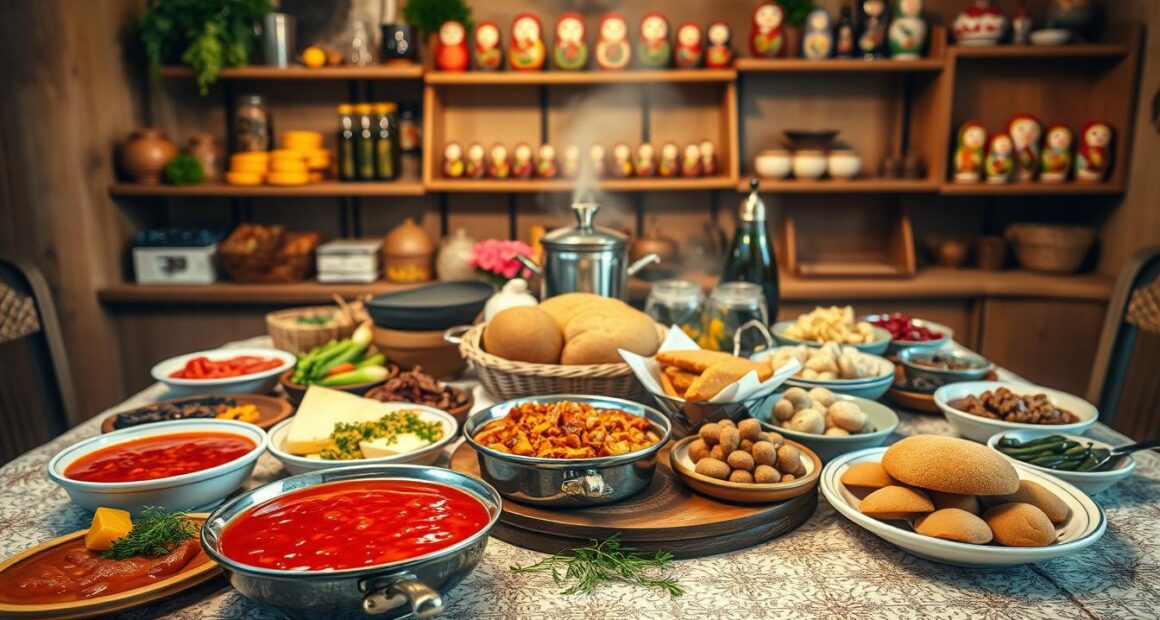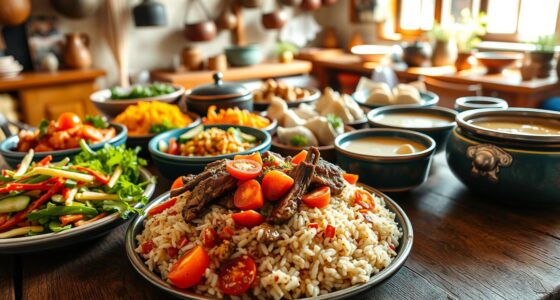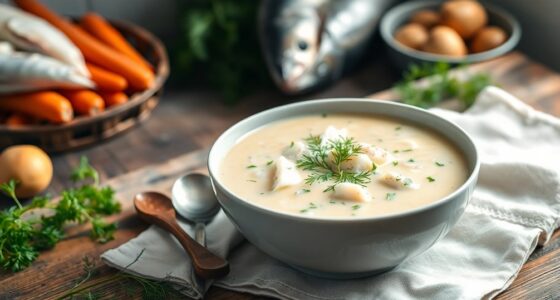Imagine sitting around a large table, surrounded by loved ones, the air filled with warm laughter and the inviting aroma of freshly prepared dishes. This scene, so common in many cultures, takes on a unique flavor in the context of Russian cuisine. In this vast and intricate world of traditional Russian food, you’ll discover a culinary journey that celebrates not only the ingredients but also age-old traditions passed down through generations. It’s a tapestry woven with threads of history and geography, where each dish tells a story of resilience and community.
From the iconic borscht—a beetroot soup that warms the soul—to pelmeni, delightful dumplings that bring comfort on cold winter nights, Russian gastronomy offers a treasure trove of flavors reflective of both bitter winters and joyous celebrations. As you delve into the heart of this cuisine, you’ll find that it mirrors the rich and diverse landscape of Russia itself, characterized by hearty ingredients and simple, yet profound cooking techniques. So, let’s embark on a journey to explore the colorful plates and vibrant stories that make Russian cuisine an enduring favorite around the world.
Key Takeaways
- Russian cuisine reflects a rich history shaped by geography and diverse cultures.
- Borscht is a staple dish, symbolizing resourcefulness with its mix of root vegetables.
- Pelmeni are tender dumplings with a meaty filling, perfect for hearty winter meals.
- Blini, similar to pancakes, play a significant role during celebrations, notably the Maslenitsa festival.
- Dairy products, especially sour cream, are vital components in enhancing the flavor of dishes.
Introduction to Russian Cuisine
Russian cuisine offers a fascinating glimpse into the country’s rich cultural heritage. This unique Russian food is not just a collection of recipes; it embodies centuries of history, regional diversity, and culinary innovations influenced by the geography of Russian cuisine. With expansive territories ranging from the icy Siberian plains to the lush Black Sea shores, each area contributes its special ingredients and cooking methods, shaping the vibrant tapestry of flavors in Russian culinary traditions.
What Makes Russian Food Unique?
Hearty and robust, unique Russian food is characterized by its emphasis on preservation techniques, essential in a land where seasons dictate ingredient availability. Traditional dishes often feature root vegetables, grains, and fermented foods. Historical periods, like the Old Russian cuisine from the 9th to the 16th centuries, focused on meals cooked in a Russian oven, with fish, mushrooms, and vegetables taking center stage. The evolution of local dishes, especially during the 17th century’s division of culinary styles, showcases the dual influences of simplicity for the common people and refinement for the elite.
The Influence of Geography on Flavors
The geography of Russian cuisine plays a significant role in the variety of flavors and ingredients used across the nation. The northern regions prioritize hardy foods like rye and fish, while milder areas cultivate a wider range of vegetables and grains. This geographical diversity resulted in a blend of culinary traditions, especially during the 19th century’s surge of interest in integrating regional dishes. Modern Russian cuisine continues to reflect this diversity, enriched by ingredients and techniques from over 150 nationalities residing within its borders.
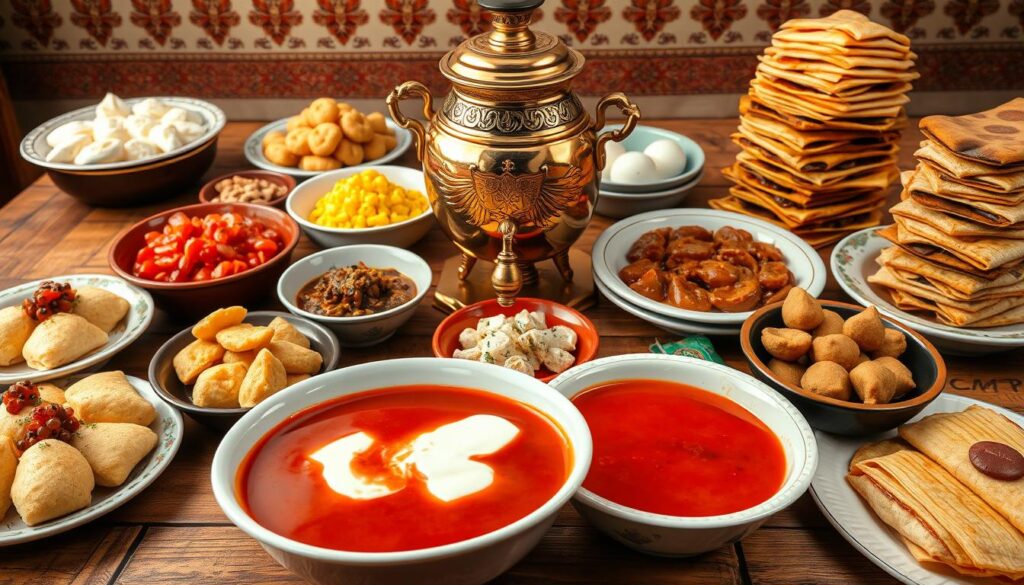
Traditional Russian Ingredients
Understanding the essence of Russian cuisine begins with its traditional Russian ingredients. These elements are not just common items in the pantry but rather the heart and soul of a myriad of dishes. They reflect the history and agricultural practices of the country, contributing to the distinct flavors that define this rich culinary culture.
Common Vegetables in Russian Cooking
Many vegetables in Russian cuisine play a pivotal role in creating hearty and fulfilling meals. Potatoes, beets, carrots, and cabbage stand out as essential Russian cooking staples. Each vegetable brings its unique texture and flavor, whether creating comforting soups or side dishes. For instance, potatoes often serve as the foundation of various recipes, while beets lend their vibrant hue to classic borscht.
Popular Meats and Fish Used
When exploring the types of proteins featured prominently in Russian cooking, you will find pork, beef, and lamb leading the way. Moreover, fish such as herring and salmon are staples, especially in coastal regions. These proteins integrate beautifully with traditional flavors and complex cooking methods, ensuring that each meal is both nourishing and delicious. The use of local spices, from black peppercorns to dill, enhances the natural flavors of these meats and fish.
The Role of Dairy Products
Dairy products are equally significant in Russian cuisine, adding layers of creaminess and richness to various dishes. Sour cream, known as smetana, is a quintessential ingredient used in many recipes, often served alongside meats and soups. It offers a delightful contrast to the robust flavors found throughout Russian dishes, showcasing the importance of traditional Russian ingredients in creating balanced and layered meals.
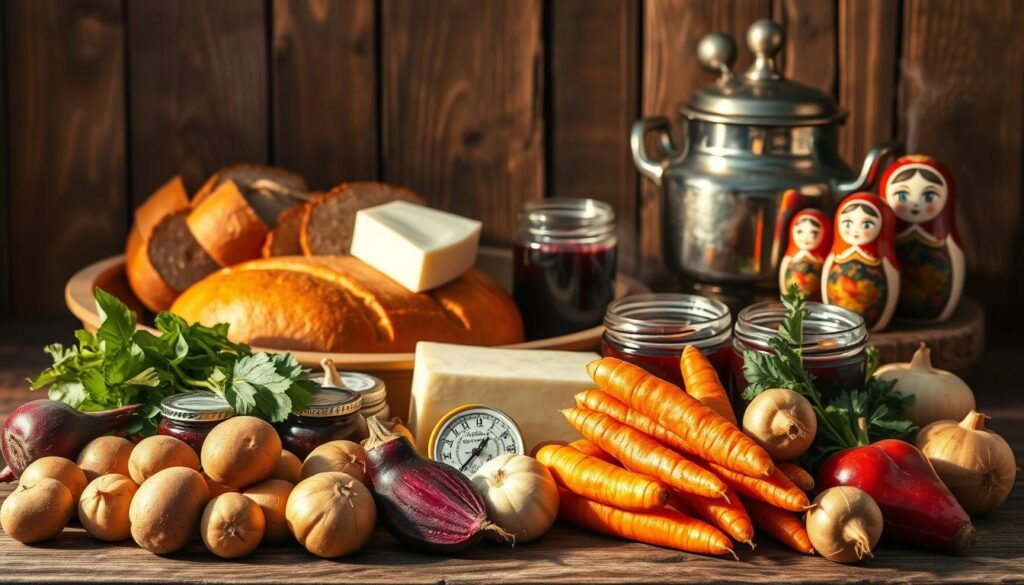
Signature Russian Dishes
Exploring signature Russian dishes reveals a tapestry of flavors and traditions that define this rich culinary heritage. From hearty soups to delightful pastries, each dish tells a story that connects to the country’s culture and history.
Borscht: The Iconic Beet Soup
Borscht stands out as one of the most beloved soups in Russian cuisine. This vibrant beet soup, often enjoyed with a dollop of sour cream and a sprinkle of fresh dill, boasts a borscht recipe that has likely evolved since the 14th-century Kievan Rus’. Primarily made from beetroot, this comforting dish also includes ingredients like cabbage, potatoes, onions, carrots, and tomato paste, reflecting the seasonal nature of Russian cooking.
Pelmeni: Delicious Dumplings
When it comes to comfort food, pelmeni hold a special place on Russian tables. Traditionally made in the Ural Mountains for over 600 years, these dumplings feature a thin dough wrapped around a filling of minced meat or fish. Often served with sour cream or various sauces, pelmeni not only delight the taste buds but also celebrate the history of Russian culinary traditions.
Blini: Versatile Pancakes
Blini are fluffy pancakes that can be topped with a variety of ingredients, making them incredibly versatile. Whether your preference leans towards savory choices like caviar or meat, or sweet options such as honey and fruit preserves, blini toppings enhance the dining experience. These beloved pancakes are especially significant during the Maslenitsa festival, marking the end of winter and the arrival of spring.
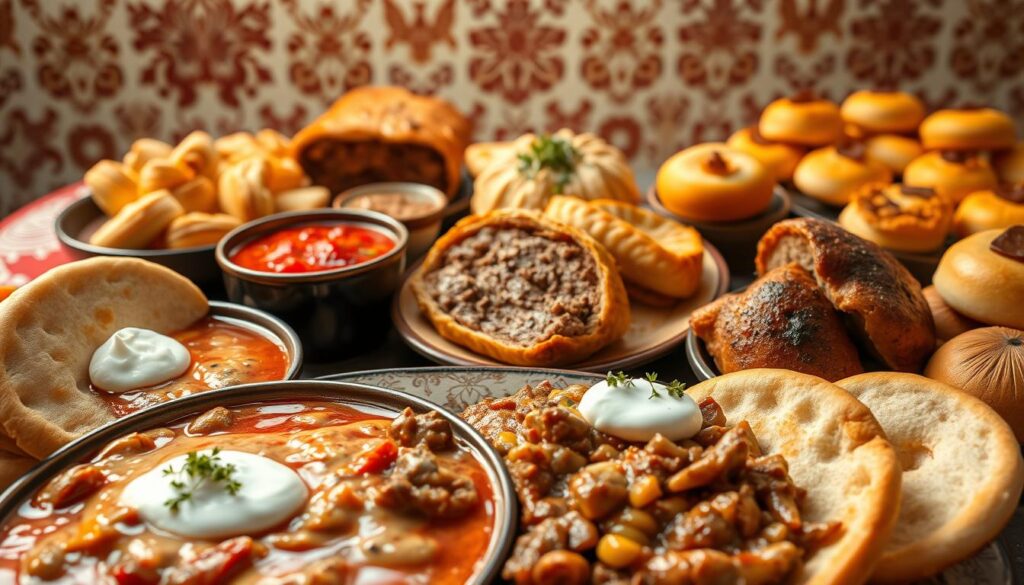
Russian Meals and Dining Customs
When you immerse yourself in Russian dining customs, you uncover a rich tapestry of traditions and practices that shape the way meals are enjoyed. Russian meals often consist of multiple courses, providing an opportunity to savor the country’s incredible cuisine. From the initial courses to main dishes and desserts, each element holds significance within Russian culture.
The Structure of a Traditional Meal
The structure of traditional Russian meals typically begins with soups or salads, leading into a main course that showcases мясо (meat) or рыба (fish) alongside vegetables or grains. Guests are usually invited to begin eating only after the host signals, highlighting the importance of communal dining. In a typical setting, toasts are common, with the notable saying “na zdrovia,” which means “to your health.” You will notice that during toasts, maintaining eye contact is customary, enhancing the sense of connection around the table.
Importance of Bread in Russian Culture
The importance of bread in Russia cannot be overstated. It is more than just a staple; it symbolizes hospitality and sustenance in traditional Russian meals. Bread is often served during any meal, typically without butter or a bread plate. Guests are expected to finish all the bread taken, as leaving it uneaten is viewed as wasteful and unlucky. The most honored position at the table coincides with bread sharing, making it a central aspect of your dining experience in Russia.

Celebratory Foods in Russia
In Russia, every holiday brings its own set of special dishes, adding to the cultural tapestry that defines celebratory Russian foods. These meals are not just about taste; they are steeped in tradition and signify moments of joy and togetherness. Whether it’s Christmas, Easter, or Maslenitsa, each festive occasion features distinct Russian holiday dishes that hold deep meanings and reflect historical practices.
Dishes for Holidays and Feasts
During Christmas, a selection of twelve dishes is prepared, one for each day leading up to the Baptism of the Lord. Among the most cherished is kutia, a sweet grain dish that symbolizes the hope for a bountiful harvest. Typically, a stuffed and baked goose takes center stage on the table, showcasing the importance of poultry in festive meals. When Maslenitsa arrives, the celebrations focus on pancakes, with the first one often tossed out to invoke good spirits. Traditional fare during this time includes syrniki, fish and cabbage pierogies, and, of course, the beloved blini. Easter feasts emphasize abundance, with hosts competing to prepare enough food to “break the table.” Kulich and Paskha, both embodying the spirit of the season, are prepared alongside beautifully dyed eggs, which serve as a colorful, edible art form.
Traditional Drinks to Pair
Every celebratory meal deserves a fitting drink. Traditional Russian drinks play a key role in these festive occasions. Vodka, with its many fine varieties, often accompanies meals, while kvass, a refreshing fermented beverage made from rye bread, provides a lighter option. These drinks enhance the enjoyment of celebratory dishes and foster a communal atmosphere during Russian holiday gatherings.
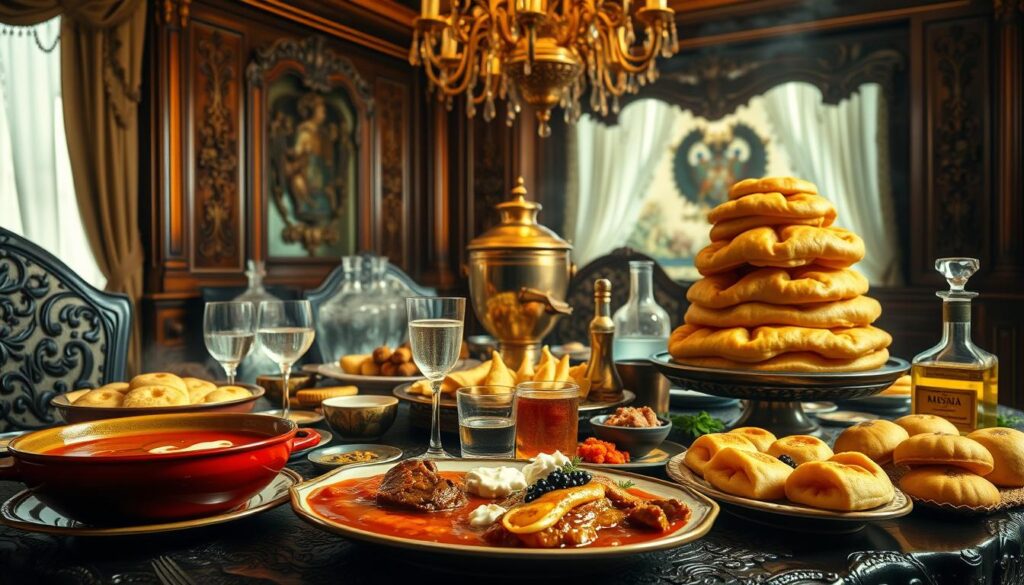
Regional Variations in Russian Cuisine
The diversity in regional Russian cuisine reflects the expansive geography and rich cultural heritage of the nation. Each area presents unique dishes that highlight local ingredients and traditions, showcasing the culinary landscape found across Russia.
Explore the Fire of Siberian Flavors
Siberian flavors epitomize hearty and rustic dishes, shaped by the region’s challenging environment. One beloved specialty is stroganina, made from frozen fish cut into thin shavings, perfectly suited to the cold climate. In Yakutia, this dish is not just food; it signifies resilience and creativity in adapting to the permafrost. Another highlight includes buuzi, steamed dumplings that resonate through Buryatia and beyond, adored for their flavorful fillings and satisfying nature.
Culinary Gems from the Volga Region
The Volga Region cuisine offers an array of delightful dishes influenced by its agricultural richness. Tatarstan stands out with its iconic triangular pies known as echpochmak, beloved throughout the country. The region’s multicultural interactions have further enriched its dishes; for instance, in Dagestan, the famous khinkal, a savory dish of boiled lamb and dough, varies in preparation across its thirty different ethnic groups. Enjoy a taste of Crimean Tatar cuisine with cheburek, a deep-fried semicircle pie filled with meat, which has become a popular street food in Crimea and the Black Sea coast.
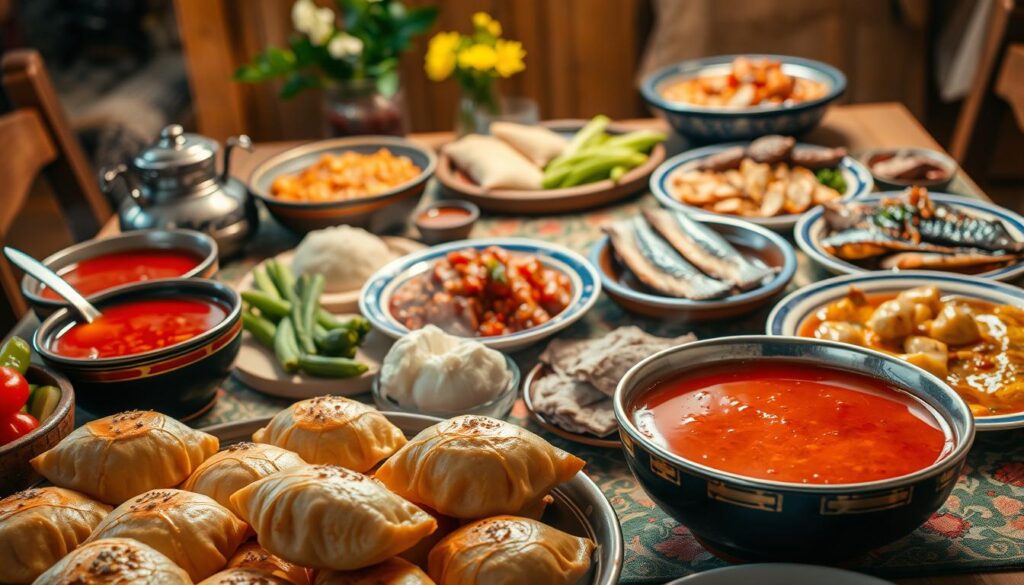
Cooking Techniques in Russian Cuisine
Understanding the cooking techniques in Russian cuisine provides an insight into how dishes are crafted to reflect flavors and traditions. Two techniques that stand out for their significance and impact on taste are slow cooking and fermentation. Both methods have been employed for generations, with each technique contributing to the survival and delight of Russian culinary culture.
Slow Cooking: A Labor of Love
Slow cooking in Russia transforms simple ingredients into rich, flavorful meals. This technique allows for deeper flavor development, bringing out the essence of meats and vegetables as they simmer over low heat for extended periods. Traditional Russian stews and braised dishes exemplify this method, where the harmony of spices and the natural sweetness of vegetables meld beautifully. The slow cooking process not only enhances taste but also aligns with the historical practices that echo the heart of Russian cooking techniques.
The Art of Fermentation
Fermentation in Russian cuisine serves as a preservation method vital for enduring harsh winters. Through this technique, foods gain unique flavors and health benefits. Common fermented items include pickled vegetables and kvass, a traditional fermented beverage. The use of fermentation reflects the resourcefulness of Russian cooks, who adapted to seasonal limitations while ensuring a varied diet. The significance of fermentation is ingrained in the culinary landscape, offering stunning flavors and contributing to the nutritional diversity found in many Russian dishes.
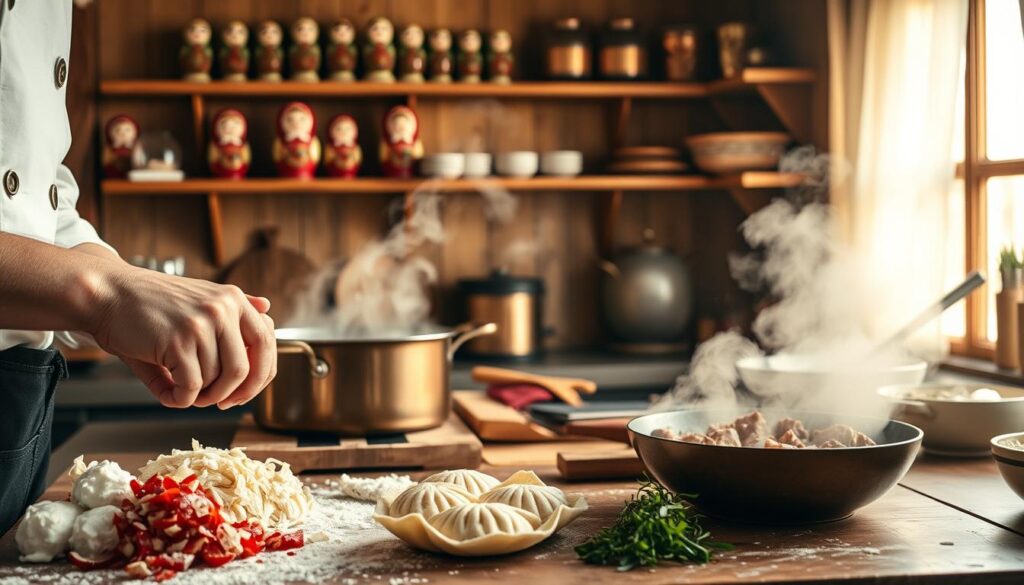
Modern Takes on Russian Classics
Modern Russian cuisine has embraced a wave of innovation, taking traditional dishes and giving them a contemporary twist. The evolution of culinary practices highlights the rich tapestry of flavors that come from Russia’s diverse cultural heritage. As chefs experiment with ingredients and techniques, they create Russian fusion dishes that are both exciting and accessible. These modern interpretations respect tradition while introducing bold new elements, making them appealing to today’s food lovers.
Fusion Dishes You Can Try
Exploring Russian fusion dishes opens up a world of culinary possibilities. Some popular examples include:
- Borscht Risotto: A creamy risotto infused with the vibrant flavors of the classic beet soup.
- Pelmeni Tacos: A fun twist that features dumplings stuffed with minced meat, wrapped in taco shells.
- Blini with Modern Fillings: Traditional pancakes topped with sushi-grade fish or avocado, creating a delightful fusion.
Where to Find Contemporary Russian Restaurants
If you’re eager to explore modern Russian cuisine, several best Russian restaurants across the country are worth visiting. Here are a few notable spots:
| Restaurant Name | Location | Specialty Dish |
|---|---|---|
| White Rabbit | Moscow | Modern Borscht |
| Fire and Ice | New York City | Lobster Pelmeni |
| St. Petersburg Bistro | Chicago | Fusion Blini |
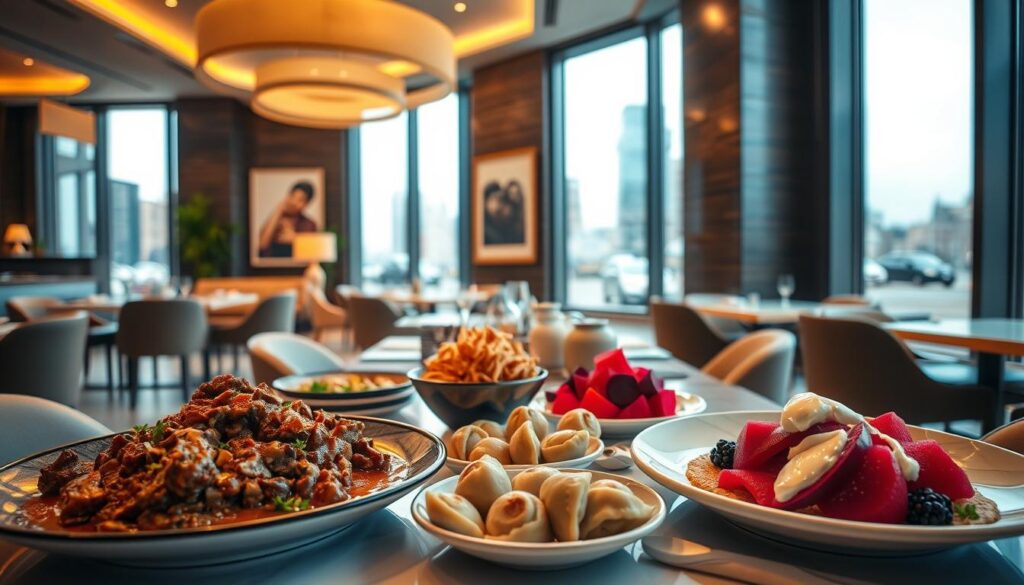
Russian Desserts and Sweets
Indulging in Russian desserts offers a glimpse into the diverse and rich culinary landscape of the country. The sweet side of Russian bakeries is brimming with an array of flavors and textures, deeply rooted in tradition. You will discover a delightful spectrum of Russian sweets that showcase not only the artistry of baking but also the cultural significance of each treat.
The Sweet Side of Russian Bakeries
Russian bakeries present an impressive selection of traditional pastries. From syrupy pirozhki to flaky layers of Napoleon cake, each confection tells a story. Medovik, a honey cake that has won hearts with its complex flavors, stands alongside other iconic desserts like Ptichye moloko, known as “bird’s milk.” These desserts often feature ingredients such as fresh fruits, nuts, and spices, merging expert craftsmanship with local produce for an unforgettable experience.
Signature Treats to Savor
Among the many Russian desserts, you will find delights like pastila, a traditional fruit confection that dates back centuries. Chak-Chak, a sweet made from dough and honey, represents a popular choice in various celebrations. The use of local ingredients is prominent in fruit-based desserts such as Kissel and Varenye, which beautifully highlight the seasonal bounty of Russia.
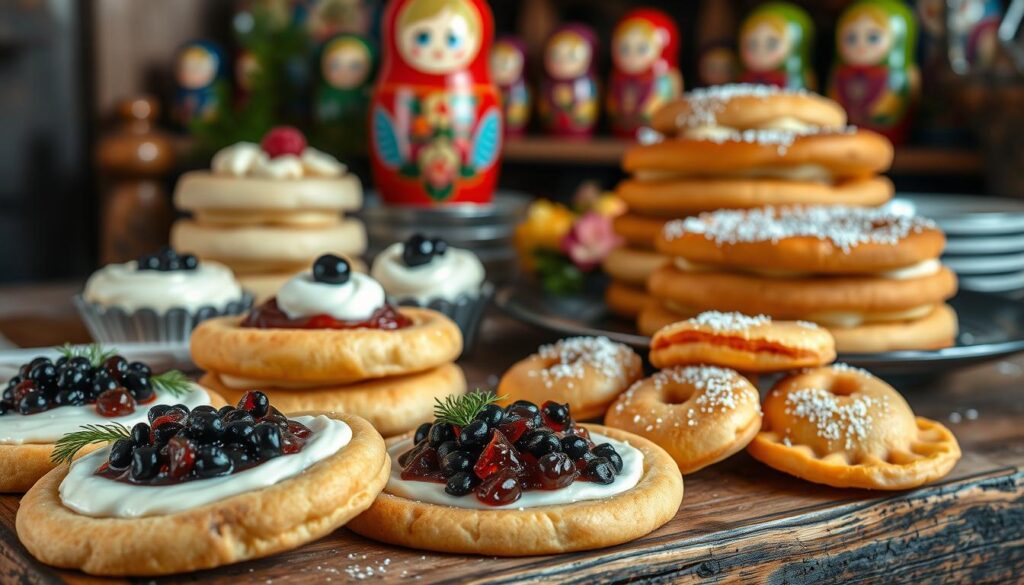
Region-specific sweets such as Tula pryanik and Vyazma pryanik emphasize the local traditions within Russian sweets. The cultural preference for desserts like Oladyi and Syrniki represents a love for pancakes and cheese-based dishes. Sweet pies filled with berries or tvorog are common, while seasonal specialties like kulich bring festive flavors to the table. Every dessert has a distinct charm, illustrating the remarkable heritage of Russian baking.
The Role of Herbs and Spices
Herbs and spices in Russian cuisine hold a crucial place, serving to elevate dishes and bring out their inherent flavors. The use of various common seasonings not only adds complexity but also reflects the rich culinary heritage of the region. As you delve deeper into enhancing flavors in cooking, understanding these ingredients enriches your appreciation for Russian cuisines.
Common Seasonings in Russian Cooking
Among the most beloved herbs and spices in Russian cooking, dill stands out as a pervasive addition. Known for its unique flavor, dill is commonly used with dishes like borscht, pelmeni dumplings, and Olivier salad. Other essential herbs include:
- Caraway: Traditionally used to alleviate stomach issues, including gas and irritable bowel syndrome.
- Celery seeds: Known for their ability to address menstrual issues and aid in lowering blood sugar levels.
- Chervil: While more common in European and Russian cooking, it enhances dishes with its delicate aniseed flavor.
- Tarragon: Another beloved herb, often used in vinegar-based dishes due to its distinct flavor profile.
How Herbs Enhance Flavor
The benefits of herbs extend beyond mere flavor. Dill, for example, offers medicinal properties, including lowering fevers and supporting liver and kidney health. Its use can be found in various forms, especially in pickled foods such as dill pickles and pickled herring. Additionally, herbs like Siberian ginseng act as adaptogens, helping the body cope with stress.
While exploring the interplay of herbs and spices in Russian cuisine, you will discover that these ingredients are influenced by historical migrations and cultural exchanges, leading to the unique flavor profiles prevalent today. This culinary journey opens doors to a richer understanding of how herbs not only enhance meals but anchor them in cultural narratives.
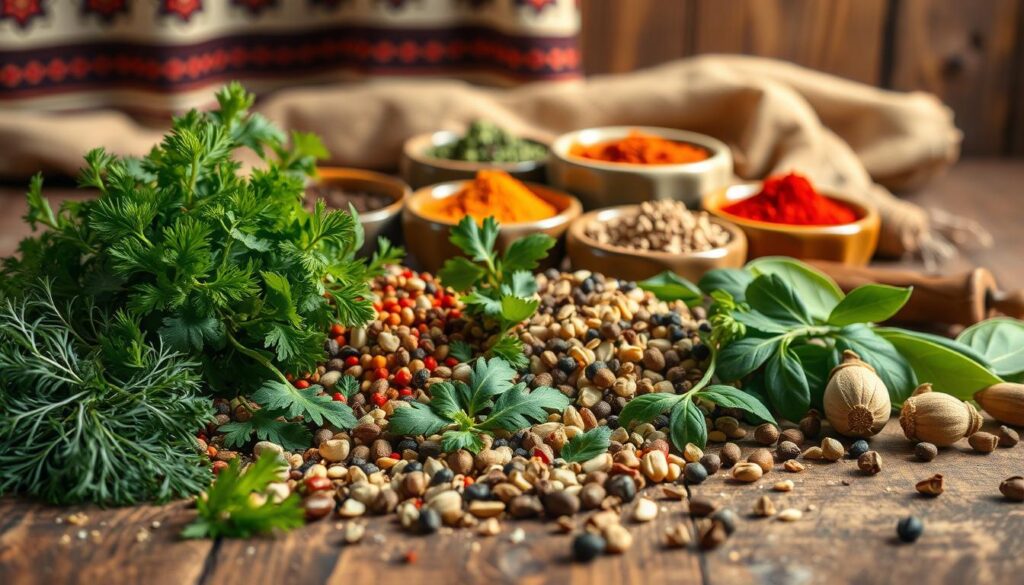
| Herb/Spice | Common Uses | Health Benefits |
|---|---|---|
| Dill | Borscht, pelmeni, pickles | Lowers fever, digestive aid |
| Caraway | Breads, stews | Relief from stomach issues |
| Celery Seeds | Soups, salads | Reduces menstrual issues, lowers blood sugar |
| Chervil | Salads, sauces | Digestive aid, mild diuretic |
| Siberian Ginseng | Teas, tonics | Stress relief, boosts energy |
Important Russian Food Festivals
Food festivals in Russia serve as vibrant platforms for celebrating cuisine, offering unique experiences that honor the nation’s rich culinary traditions. These gatherings highlight the significance of community and the inherent joy found in sharing food. You can immerse yourself in the culture by attending various authentic Russian events that showcase local flavors and traditional dishes.
Celebrating Food Through Festivals
From Moscow to St. Petersburg, the variety of Russian food festivals captures the essence of regional specialties. Here are some notable events that you should consider experiencing:
| Festival Name | Date | Location | Description |
|---|---|---|---|
| St Petersburg Gourmet Days | TBA | St. Petersburg | Approximately 40 restaurants participate, offering festive set meals for 1,500 rubles ($23) each. |
| Taste of Moscow | June 27-30, 2019 | Moscow | Four days of open-air culinary events at the Luzhniki Olympic complex. |
| Byg-Byg Finno-Ugric Gastronomic Festival | July 6-7, 2019 | Udmurtia | Attendees can open a cafe for one day with provided equipment. |
| O, da! Eda! | July 13-14, 2019 | St. Petersburg | Various culinary experiences and master classes offered, featuring 60 pop-up stalls from local startups. |
| Hold the Crab! | October 15-30, 2019 | Far East & major cities | Enjoy live crab priced at 1,200 rubles ($18) per kilo at participating restaurants. |
Events to Experience Authentic Russian Cuisine
Participating in Russian food festivals not only allows you to taste delightful dishes but also provides insight into cultural stories behind them. Events like “O, da! Eda!” feature cooking classes led by renowned chefs, while the “Young Locavore” school offers engaging activities for children. Music performances and food styling sessions further enrich the experience. During the “Byg-Byg” festival, you can even step into the role of a restaurateur for a day. Each festival celebrates the shared love of food, bringing communities together through unique and authentic experiences.
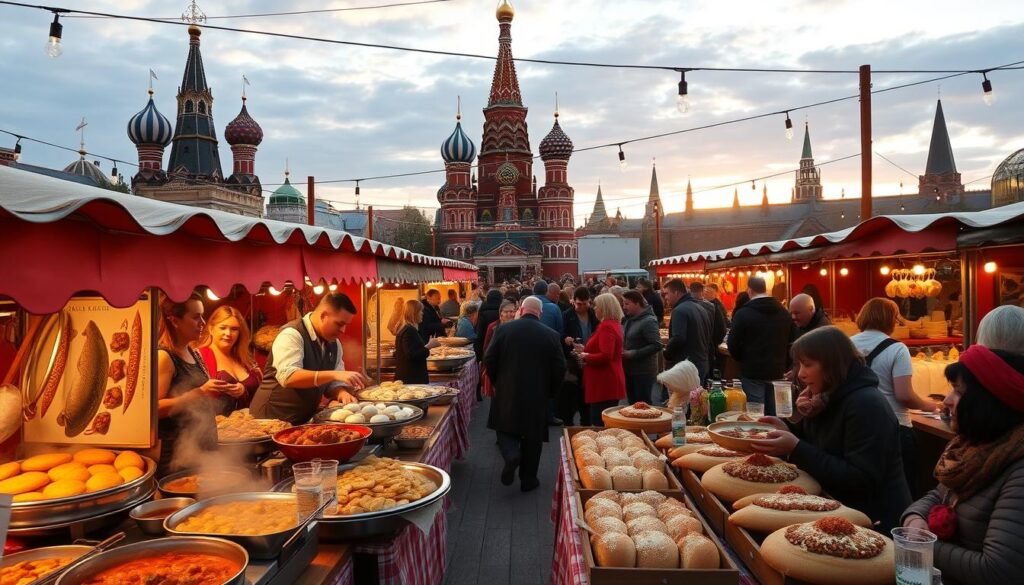
Sourcing Russian Ingredients in the U.S.
Finding authentic Russian ingredients in the U.S. can enhance your culinary experience, allowing you to recreate traditional dishes with genuine flavors. Specialty stores and online retailers have made sourcing Russian ingredients much more accessible. Many locations offer a variety of items, from staples to unique products, that reflect the rich heritage of Russian cuisine.
Where to Find Authentic Russian Products
To discover authentic Russian products, you can start by searching for local Russian markets or ethnic grocery stores. These establishments typically carry a wide selection of goods, including:
- Rye bread
- Kvass
- Sunflower oil
- Canned herring and salmon
- Traditional candies like zefir and halva
Many of these markets also provide delivery services across the U.S., with some offering free shipping on orders exceeding $200, which makes shopping for Russian food even more convenient.
Tips for Shopping at Local Markets
When shopping for Russian ingredients, keep these tips in mind to ensure a successful experience:
- Explore a variety of stores to compare product offerings and prices.
- Check for fresh produce, including berries, mushrooms, and vegetables, as these are staples in Russian cuisine.
- Look for bulk sections where you can purchase grains and other dry goods.
- Don’t hesitate to ask store staff about traditional ingredients and their uses.
Customer feedback often highlights the joy of online ordering for these ingredients, especially with the efficient processing and delivery services available. Enjoy the process of shopping and tasting authentic Russian products straight from your kitchen!
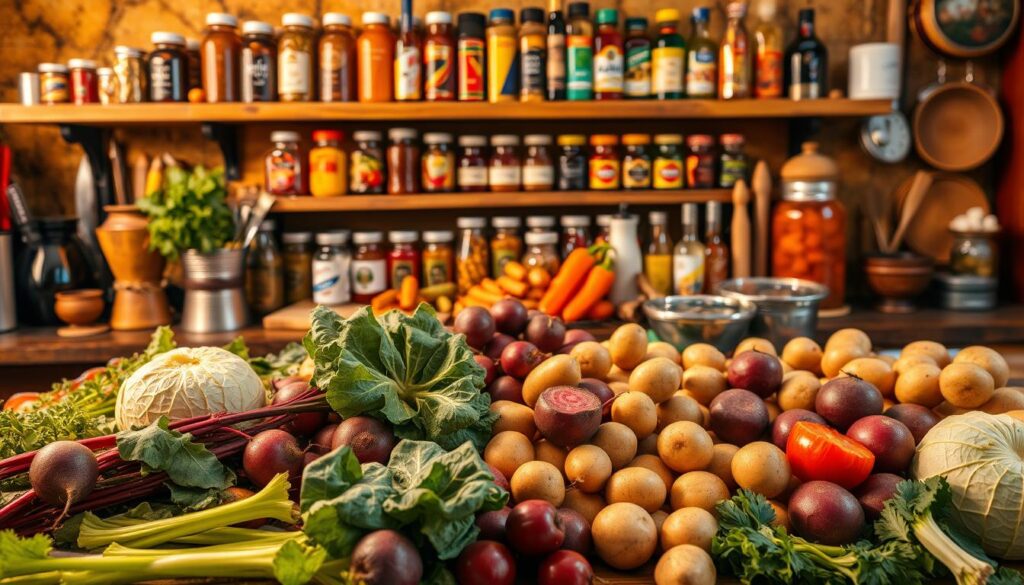
Cooking Russian Cuisine at Home
Cooking Russian food at home allows you to explore a world of flavors and traditions. You can easily start with quick Russian recipes that bring the essence of Russian cuisine into your kitchen. From comforting soups to delightful pastries, there’s something for everyone to enjoy.
Quick Recipes to Get Started
Begin your culinary journey with recipes that are not only delicious but also manageable. Consider making:
- Borscht: A hearty beet soup that requires a bone-in beef shank, served with the vibrant colors of beets and cabbage. Cooking time can reach up to 4.5 hours, offering deep flavors.
- Pelmeni: Russian dumplings that are perfect for any occasion, filled with minced meat and served with sour cream.
- Blini: Thin pancakes that can be filled or topped with a variety of ingredients. Ideal for breakfast or dessert and can be prepared in under 30 minutes.
Essential Kitchen Tools for Russian Cooking
To successfully create these dishes, equip your kitchen with essential tools. Here are some must-have kitchen tools for Russian cuisine:
| Kitchen Tool | Purpose |
|---|---|
| Rolling Pin | For rolling out dough for dumplings and pastries. |
| Sturdy Pot | Perfect for boiling soups and stews, like Borscht. |
| Wooden Utensils | Gentle on cookware and ideal for mixing and serving. |
| Measuring Cups | Ensure proper measurements for baking and cooking. |
| Knives | For chopping vegetables and preparing ingredients. |

Conclusion: Embracing Russian Cuisine
Exploring Russian cuisine offers you a window into a vibrant world filled with unique flavors and rich culinary narratives. This diverse cuisine reflects the vast landscapes of Russia that spans two continents, resulting in a delightful mix of ingredients and dishes shaped by regional influences and historical events. You will discover that Orthodox fasting periods have led to the creation of an impressive variety of vegetarian dishes, further enriching the experience of exploring Russian flavors.
Your journey through Russian food can be an exciting adventure as you sample beloved traditional dishes like borscht and pelmeni, or even try your hand at cooking them at home. Each bite brings you closer to appreciating the cultural significance of these meals, intertwined with historical influences from Mongol invasions to European customs adopted by the ruling elites. This multifaceted culinary heritage invites you to embrace Russian cuisine wholeheartedly.
As you savor each dish, you’ll find that both old and new techniques play a role in the preparation, with traditional preservation methods and contemporary adaptations alike enhancing the flavors. Whether it’s the comforting warmth of blini during celebrations or the tangy notes of fermented favorites, your journey into Russian gastronomy is just beginning, promising delightful surprises at every turn.
